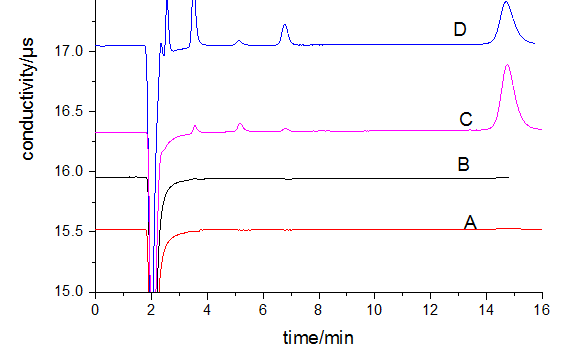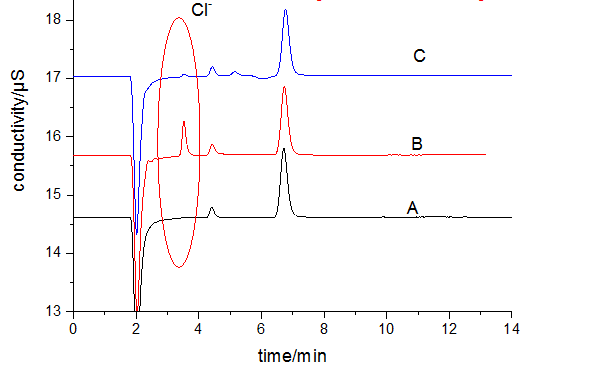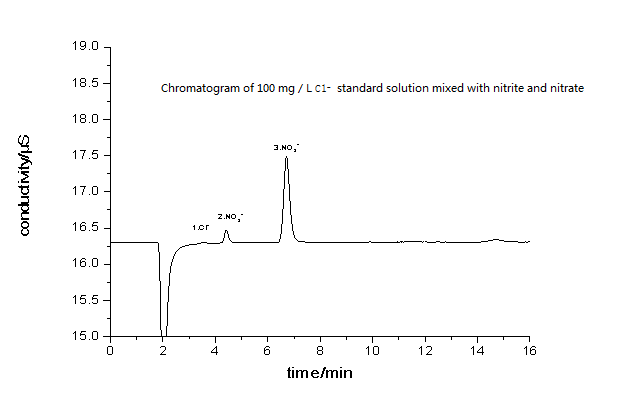MS-Clean IC
MS-Clean™ IC Series pretreatment ion colum1、 Foreword
MS-Clean™ IC Series of sample pretreatment ion column products are suitable for all kinds of samples (such as all kinds of food, flour, dairy products, drinking water, cosmetics )Solid phase extraction of analyte and matrix elimination of sample were carried out. The so-called sample matrix removal refers to the use of the combination between the matrix component in the sample and the stationary phase in the sample pretreatment column to keep the interference component in the matrix on the sample pretreatment column, while the analyte is not retained directly through the sample pretreatment column, so as to carry out subsequent analysis and determination. In this way, the interference of the coexisting components in the sample matrix to the determination can be eliminated. For the direct solid-phase extraction method of analyte, when the solution of the sample is passed through the sample pretreatment column, the analyte is directly retained on the sample pretreatment column due to its unique binding effect, while the matrix component in the sample is not retained, so the analyte is extracted on the sample pretreatment column through the sample pretreatment column, and then the analyte is extracted on the sample pretreatment column by the appropriate eluent This method can also achieve the functions of analyte
enrichment and sample matrix removal.


The application of the patented technology completely solves the problem of column collapse caused by high pressure. At the same time, the pretreatment of small columns with large column capacity can eliminate the matrix more thoroughly.
MS-Clean™ IC Important technical indexes of series ion small columns:
Table 1 shows MS clean ™ IC series sample pretreatment column and its application:
|
Column type and specification |
Functional group |
Application example |
|
IC-A(1.0cc) |
HCO3 type quaternary amine salt |
Removal of strongly retained anions and adjustment of solution pH |
|
IC-Ag(1.0cc) |
Ag + sulfonate |
Removal of halogen anion |
|
IC-Ag/H(1.0cc) |
Ag + sulfonate + sulfonic acid |
Removal of halogen anion and excess Ag + |
|
IC-Ba(1.0cc) |
Ba2 + sulfonate |
SO42-Removal of |
|
IC-H(1.0cc) |
sulfonic acidNa + sulfonate |
Removal of cations (heavy metals) and regulation of alkaline solutionRemoval of cations (heavy metals) |
|
IC-RP(1.0cc) |
Divinylbenzene |
Removal of hydrophobic compounds and hydrophobic substances containing hydrophilic groups, such as aromatic compounds |
2、 MS clean ™ Application of IC series sample pretreatment column
2.1 MS-Clean ™ Pretreatment of IC series sample pretreatment column
In order to get the best analysis results, Ms clean is used ™ The following principles shall be followed in the pretreatment of IC series samples.
1) When using manual sample pretreatment, in order to provide necessary pressure for sample pretreatment column, 5ml size syringe should be used.
5) If the substance to be removed is a colored material or other substance that can be observed by human eyes (such as AgCl precipitation), the sample pretreatment column can be used until the colored band extends to 3 / 4 of the outlet of the sample pretreatment column. In some special applications, if you want to get the absolute maximum sample loading capacity of the pretreatment column, you can let the sample solution pass through the pretreatment column all the time, and use appropriate detection methods for continuous detection until the penetration of the column is observed.
|
Column type and specification |
Flushing reagent |
Volume of flushing agent(mL) |
Maximum flow rate(mL/min) |
Volume of effluent to be discarded (ML) |
|
IC-A |
|
|
|
|
|
1.0cc |
Deionized water |
10 |
2 |
3 |
|
|
Deionized water |
16 |
2 |
6 |
|
IC-Ag |
|
|
|
|
|
1.0cc |
Deionized water |
10 |
2 |
3 |
|
|
Deionized water |
16 |
2 |
6 |
|
IC-Ag/H |
|
|
|
|
|
|
Deionized water |
16 |
2 |
6 |
|
IC-Ba |
|
|
|
|
|
1.0cc |
Deionized water |
10 |
2 |
3 |
|
|
Deionized water |
16 |
2 |
6 |
|
IC-H |
|
|
|
|
|
1.0cc |
Deionized water |
10 |
2 |
3 |
|
|
Deionized water |
16 |
2 |
6 |
|
IC-RP |
|
|
|
|
|
1.0cc |
1.methanol |
5 |
4 |
3 |
|
IC-Na |
1.methanol |
12 |
4 |
6 |
2.2 how to use MS clean ™ Recovery test of IC series sample pretreatment column

It can be seen from the comparison spectrum that Ms clean ™ The ion residual concentration in IC series pretreatment column is very low, which ensures the accuracy of detection. However, there are nitrate and sulfate ions in some brands and imported brands, which will affect the detection of actual samples.
2.4 MS-Clean™ IC-Agcolumn
MS-Clean™ IC- AGThe column packing of the column contains the silver salt Ag + form of strong acid cation exchange resin. In addition to the ionic silver salt Ag + form MS-Clean™ IC -Ag Column packing andMS-Clean™ IC-H The packing of the column is similar.MS-Clean™ IC-Ag The role of the column is to use the principle of silver salt precipitation to remove the Cl-、Br-、I-、AsO43-、CrO42-、CN-、MoO42-、PO43-、SeO32-、SeCN-、SO32-、S2-、SCN-andWO42-plasma.The recovery of the target compound should be investigated before using this method.In addition, the recovery of NO3- ions in acid solution is low, and the recovery depends on the acidity and volume of the sample solution.
When the resin is fully expanded with water, 1.0cc MS-Clean™ IC-Ag The column capacity is 2.0 ~ 2.2meq,Specification MS-Clean™ IC Ag The column capacity is 6.0 ~ 6.6meq.For example, using the 1.0cc specification MS-Clean™ IC -Ag The column can handle about 9ml of 1% NaCl solution, using 2.5 CC MS-Clean™ IC-Ag The column can handle about 27ml of the solution.In use MS-Clean™ IC Ag There is often a joint at the back of the column MS-Clean™ IC -H colum.Its purpose is to use MS-Clean™ IC- H The column captures the possible penetration of Ag + ions, which can protect the subsequent analytical column.
You should also pay special attention to the use of MS clean ™ IC-Ag column timeThe pH of solution should be below 7.0. If the pH of solution is equal to or greater than 7, silver oxide precipitate will be generated to make MS clean ™ The IC-Ag column turns black.
2.4.1 recovery data
Use MS clean ™ When IC-Ag column,The recoveries of 2 mg /L F-, 10 ppm SO42- - and 15ppm NO3-were over 98%.If the recovery of the analyte is low, the sample should be diluted properly. Sometimes, the adsorption of analyte on the precipitation will occur.Table 3 shows the ms-clean with specifications ™ Residual situation of Cl - ion in solution after IC Ag column treatment
|
Cl-Initial concentration(mg/L) |
Cl-Residual concentration(mg/L) |
|
0 |
0.10 |
|
100 |
0.1 |
|
200 |
0.1 |
|
300 |
0.12 |
|
400 |
0.13 |

In the figure:
A is 100mg / L Cl- standard solution passing MS clean ™ Chromatogram after IC-Ag small column

It can be seen from the chromatogram that the high concentration chloride solution passes through MS clean ™ After IC Ag column, the removal rate of chloride ion is over 99.95%, which solves the interference problem of nitrite ion determination.
2.5 MS-Clean™ IC Ag/H column
MS-Clean ™ IC-Ag /H column () is a laminated composite resin column containing IC-Ag and IC-H resins.
MS-Clean™ IC- Ag/H The column packing contains high capacity strong acid cation exchange resin (IC Ag) in the form of silver salt.The column can be used to produce precipitation by removing it from the sample solutionCl-、Br-、I-、AsO43-、CrO42-、CN-、MoO42-、PO43-、SeO32-、SeCN-、SO32-、S2-、SCN- and WO42-Waiting for Laozi.When the sample is treated by this method, the recovery of the analyte should be determined and investigated. The recovery of NO3- may be low when the sample is treated in acid sample solution. The degree of the low recovery depends on the pH of the solution and the volume of the sample solution.
MS-Clean™ IC- Ag/H The packing of the column also contains the H+ type strong acid polystyrene type cation exchange resin(IC-H)。The resin has a good choice for multivalent cations such as transition metal ions and Ca2+.The original design of the composite column is to remove the higher concentration of alkaline earth metal and transition metal ions from the sample matrix, neutralize the strong alkaline sample solution and remove the carbonate CO32-.In the structure of the composite column, Ms clean Gamma The IC h resin is placed in the outer layer of the two-layer structure, which can remove soluble Ag+ ions and other cations from the sample matrix.This two-layer composite column can be used to replace two single columns connected in series. In addition, the column also has the total amount of Ag+ removed.
MS-Clean™ IC-Ag/H The column capacity of the column is 5.5meq(IC -Ag)and 1.0meq(IC-H)。
2.6 MS-Clean™ IC-RP
MS-Clean™ IC-RP The column packing is a kind of reverse packing with macroporous structure. This kind of resin has high selectivity for hydrophobic compounds, especially unsaturated compounds and aromatic compounds, and can match with organic solvents of high performance liquid chromatography. It can keep stable in the whole pH range, i.e. pH0 ~ 14.IC-RPcolumn can be used in many fields instead of C18 bonded silica gel in many cases,Especially when the acidity or alkalinity of the sample solution is very strong。IC- RP The column is mainly recommended to remove the following substances from the sample matrix: aromatic dyes, hydrocarbons, surfactants and some organic carboxylic acids.IC- RP The column can also be used for the enrichment of some trace components. In this technology, some trace substances are first separated from the sample matrix and concentrated on the IC-RP column,Then, these substances are eluted from the column with the smallest amount of suitable solvent. In this process, the purpose of separation and enrichment of trace substances is achieved. Since the column packing does not contain anion and cation exchange sites, it will not retain ionic substances, so before ion exchange analysis,IC-RP column is often used to remove hydrophobic pollutants from the sample matrix.In the reverse phase mode, the main mode of action of PVB resin is hydrophobicity. When the IC-RP column is used to treat the aqueous solution, the column should be treated with appropriate amount of methanol (see Table 2: pretreatment methods of various sample pretreatment columns). The main purpose of methanol treatment is to wet the surface of the filler, so as to maximize the treatment efficiency of the resin. From the following two experiments, we can fully see the effect of column treatment with methanol:Two IC-RP columns were used to treat 5 ml 1000 ppm sodium dodecyl sulfate solution at a flow rate of 4.0 ml / min.One of the two columns was pretreated with methanol and the other was not pretreated with methanol. The concentration of sodium dodecyl sulfate in the solution from the column pretreated with methanol was 24ppm, while that from the column pretreated with methanol was 979ppm. This shows that the IC-RP column without methanol treatment has no reservation for anionic surfactants.
2.6.1 recovery data
It can be seen from table 5 that for organic carboxylic acids with strong hydrophobicity, adding a small amount of isopropanol into their solution is conducive to increase the recovery of carboxylic acids.
Table 5 ms clean ™ Recovery of some carboxylic acids by IC-RP column
|
Substance (concentration ppm) |
pH2.5(aq) |
pH4.5(aq) |
pH4.5(2%IPA) |
pH 6(aq) |
|
acetic acid (5) |
50% |
81% |
100% |
100% |
|
Valeric acid (20) |
0% |
0% |
10% |
3% |
|
Benzoicacid (10) |
0% |
3% |
14% |
8% |
|
Succinicacid (10) |
50% |
100% |
100% |
98% |
|
tartaric acid (10) |
100% |
101% |
100% |
100% |
|
Note: the accuracy of measurement results is within 5% |
||||
2.6.2 MS-Clean™ IC- RPColumn application: removal of surfactants
In addition to being used in reverse phase mode, IC-RP columns can also be used in the removal of ionic materials by ion pair. In this way, the recommended ion pair reagent is tetramethylammonium hydroxide. The loss of inorganic anions increases significantly when using ion pair reagents larger than tetramethylammonium hydroxide, such as tetraethylammonium hydroxide and tetrapropylammonium hydroxide.Any substance that can be retained by MPIC with NH4OH or tmaoh ion pair reagent can be removed from the sample matrix by ion pair with IC-RP column. Generally speaking, for the removal of anions, the column capacity of 1.0cc ic-rp column is larger when the ion pair is used than when the reversed-phase operation is used; for example, in the reversed-phase mode, the amount of sodium dodecyl sulfate that can be removed by 1.0cc ic-rp column is 20 mg, while when tetramethylammonium hydroxide is used as the reagent and the ion pair operation mode is used, 1.0cc IC -90 mg of sodium dodecyl sulfate can be removed by RP column. In reverse mode,MS-Clean™ IC -RPColumn pair F-、Cl-、PO43-、NO3-、and SO42- rate of recovery>98%;When tetramethylammonium hydroxide is used as reagent and ion pair operation is used, Ms clean ™ The recovery of these ions by IC-RPcolumn is more than 96%.
2.7 MS-Clean™ IC -A column
MS-Clean™ IC -A column(1.0cc)HCO3-Polydivinylbenzene strong base anion exchange resin. The resin is an anion selective resin, which is mainly used for the removal of anionic impurities in the sample matrix and neutralization of acid samples. It is mainly suitable for the analysis of cation. The column is also used to remove anionic amino acids, peptides, proteins and other contaminants from glycoprotein hydrolysates or carbohydrate samples. When the water is fully swollen,The exchange capacity of 1.0 cc IC-A column is 0.7 meq, and that of IC-A column is 2.1 meq. In addition, the resin remained stable at pH 0 ~ 14.
3、 Select MS clean related ion column according to relevant standards
|
No |
Standard No |
Standard name |
Pretreatment column type |
Pretreatment column action |
|
1 |
GB/T 20188-2006 |
Wheat flour determination of bromate ion chromatography |
Ag / h composite type, or Ag column and H column in series. |
Remove chloride ion and eliminate its interference to chloride ion |
|
2 |
GB/T 24800.13-2009 |
Cosmetics - Determination of nitrite - ion chromatography |
IC-RP |
Remove the organic matter from the sample |
|
3 |
GB/T 24876-2010 |
Determination of seven anions in livestock wastewater by Ion Chromatography |
IC-RP、IC-H |
RP:Removal of organic matter; H-column: removal of heavy metals |
|
4 |
HJ84-2016 |
Water quality -- Determination of inorganic anions -- IonChromatography |
IC-RP、IC-H |
RP:Removal of organic matter; H-column: removal of heavy metals |
|
5 |
HJ812-2016 |
Water quality -- Determination of inorganic cations -- Ion Chromatography |
IC-RP |
RP:Removal of organic matter |
|
6 |
HJ799-2016 |
Ambient air particles determination of water soluble anions ion chromatography |
IC-RP、IC-H |
RP:Removal of organic matter; H-column: removal of heavy metals |
|
7 |
HJ778-2015 |
Water quality -- Determination of iodide -- Ion Chromatography |
IC-RP、IC-H |
RP:Removal of organic matter; H-column: removal of heavy metals |
|
8 |
NY/T 1374-2007 |
Determination of fluorine in plant products by Ion Chromatography |
IC-H |
Remove the carbonate produced during sample treatment |
|
9 |
NY/T 1374-2007 |
Determination of nitrite and nitrate in plant products by Ion Chromatography |
IC-RP |
Remove the organic matter from the sample |
|
10 |
SN/T 3138-2012 |
Determination of bromate in flour products for export |
IC-RP、IC-Ag,IC-H |
IC-RP column: removal of organics in samples |
|
11 |
SN/T 3151-2012 |
Determination of nitrite and nitrate in export food by Ion Chromatography |
IC-RP、IC-Ag、IC-H |
IC-RP column: removal of organics in samples |
|
12 |
SN/T 3528-2013 |
Cosmetics for import and export -- Determination of sulfite and bisulfite -- Ion Chromatography |
IC-RP |
Remove the organic matter from the sample |
|
13 |
SN/T 3608-2013 |
Cosmetics for import and export -- Determination of fluorine -- Ion Chromatography |
IC-H |
Remove the carbonate produced during sample treatment |
|
14 |
SN/T 3636-2013 |
Determination of sulphate in export food by Ion Chromatography |
IC-RP、IC-Ag、IC-Na |
IC-RP column: removal of organics in samples |
|
15 |
SN/T 3727-2013 |
Determination of iodine content in exported food by Ion Chromatography |
IC-RP |
IC-RP column: removal of organics in samples |
|
|
SN/T 3931-2014 |
Determination of formic acid and its salts in exported food by Ion Chromatography |
IC-RP、IC-Ag、IC-Na |
IC-RP column: removal of organics in samples |
|
17 |
SN/T 4041-2014 |
Determination of fluoride and bromides in exported food by Ion Chromatography |
IC-RP |
IC-RP column: removal of organics in samples |
|
18 |
SN/T 4049-2014 |
Determination of chlorate in food for export -- Ion Chromatography |
IC-RP |
IC-RP column: removal of organics in samples |
|
19 |
SN/T4392-2015 |
Cosmetics and soap products - Determination of hydroxyethylphosphoric acid and its salts - ion chromatography |
IC-RP |
IC-RP column: removal of organics in samples |
|
20 |
GB/T 5009.33-2010 |
Determination of nitrite and nitrate in food |
IC-RP、IC-Ag、IC-H |
IC-RP column: removal of organics in samples |
|
21 |
|
Raw milk and milk products -- Determination of thiocyanate -- Ion Chromatography |
IC-RP |
removal of organics in samples |
|
Ordering information: |
||||
|
Part No |
name |
Specifications |
purpose |
|
|
MSICH1000 |
IC-H type |
1000mg,1cc,50branch/pk |
The alkaline earth metal ions, transition metal ions and carbonate ions in the sample matrix are removed, which are also used to neutralize the strong alkalinity of the sample solution. |
|
|
MSICNA1000 |
IC-Na type |
1000mg,1cc,50branch/pk |
Remove transition metal ions and alkaline earth metal ions from the sample. |
|
|
MSICAG1000 |
IC-Ag type |
1000mg,1cc,50branch/pk |
Remove the Cl-、Br-、I-、AsO43-、CrO42-、CN-、MoO42-、PO43-、SeO32-、SeCN-、SO32-、S2-、SCN-andWO42- |
|
|
MSICAGH1000 |
IC-Ag/H mixed type |
1000mg,1cc,50branch/pk |
||
|
MSICRP1000 |
IC-RP type |
1000mg,1cc,50branch/pk |
Remove hydrophobic compounds, especially unsaturated compounds and aromatic compounds with pH range of 0-14. |
|
|
MSICBA1000 |
IC-Ba type |
1000mg,1cc,50branch/pk |
Remove the sulfate ion from the sample. |
|
|
MSICC181000 |
IC-C18 type |
1000mg,1cc,50branch/pk |
Remove hydrophobic compound pH range 2-8. |
|


